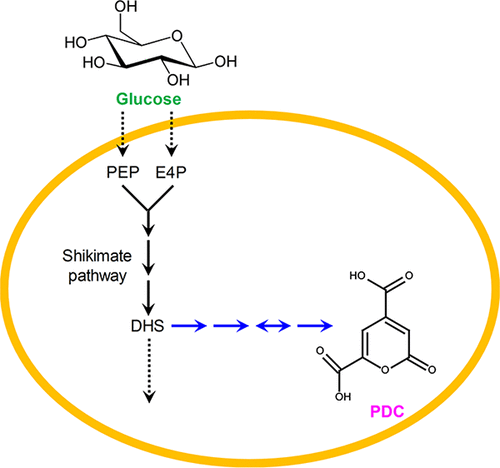当前位置:
X-MOL 学术
›
ACS Synth. Biol.
›
论文详情
Our official English website, www.x-mol.net, welcomes your
feedback! (Note: you will need to create a separate account there.)
Metabolic Engineering of Escherichia coli for Efficient Production of 2-Pyrone-4,6-dicarboxylic Acid from Glucose
ACS Synthetic Biology ( IF 3.7 ) Pub Date : 2018-08-10 00:00:00 , DOI: 10.1021/acssynbio.8b00281 Zi Wei Luo 1, 2 , Won Jun Kim 1, 2 , Sang Yup Lee 1, 2, 3
ACS Synthetic Biology ( IF 3.7 ) Pub Date : 2018-08-10 00:00:00 , DOI: 10.1021/acssynbio.8b00281 Zi Wei Luo 1, 2 , Won Jun Kim 1, 2 , Sang Yup Lee 1, 2, 3
Affiliation

|
2-Pyrone-4,6-dicarboxylic acid (PDC) is a pseudoaromatic dicarboxylic acid and is a promising biobased building block chemical that can be used to make diverse polyesters with novel functionalities. In this study, Escherichia coli was metabolically engineered to produce PDC from glucose. First, an efficient biosynthetic pathway for PDC production from glucose was suggested by in silico metabolic flux simulation. This best pathway employs a single-step biosynthetic route to protocatechuic acid (PCA), a metabolic precursor for PDC biosynthesis. On the basis of the selected PDC biosynthetic pathway, a shikimate dehydrogenase (encoded by aroE)-deficient E. coli strain was engineered by introducing heterologous genes of different microbial origin encoding enzymes responsible for converting 3-dehydroshikimate (DHS) to PDC, which allowed de novo biosynthesis of PDC from glucose. Next, production of PDC was further improved by applying stepwise rational metabolic engineering strategies. These include elimination of feedback inhibition on 3-deoxy-d-arabino-heptulosonate-7-phosphate synthase (encoded by aroG) by overexpressing a feedback-resistant variant, enhancement of the precursor phosphoenolpyruvate supply by changing the native promoter of the ppsA gene with the strong trc promoter, and reducing accumulation of the major byproduct DHS by overexpression of a DHS importer (encoded by shiA). Furthermore, cofactor (NADP+/NADPH) utilization was manipulated through genetic modifications of the E. coli soluble pyridine nucleotide transhydrogenase (encoded by sthA), and the resultant impact on PDC production was investigated. Fed-batch fermentation of the final engineered E. coli strain allowed production of 16.72 g/L of PDC from glucose with the yield and productivity of 0.201 g/g and 0.172 g/L/h, respectively, representing the highest PDC production performance indices reported to date.
中文翻译:

大肠杆菌的代谢工程技术,可有效地从葡萄糖中生产2-吡喃酮-4,6-二羧酸
2-Pyrone-4,6-二羧酸(PDC)是一种假芳香族二羧酸,是一种很有前途的生物基建材化学品,可用于制备具有新型功能的多种聚酯。在这项研究中,对大肠杆菌进行了代谢工程改造,以从葡萄糖生产PDC。首先,计算机模拟代谢通量模拟提出了从葡萄糖生产PDC的有效生物合成途径。此最佳途径采用单步生物合成途径来合成原儿茶酸(PCA),这是PDC生物合成的代谢前体。所选择的PDC的生物合成途径,莽草酸脱氢酶(由编码的基础净资产回报率)缺陷的大肠杆菌通过引入不同微生物来源的异源基因来工程化该菌株,所述异源基因编码负责将3-脱氢D草酸酯(DHS)转化为PDC的酶,从而允许从葡萄糖从头开始生物合成PDC。接下来,通过应用逐步合理的代谢工程策略进一步提高了PDC的产量。这些包括在3个脱氧反馈抑制的消除d -arabino-heptulosonate -7-磷酸合成酶(由编码aroG通过改变所述的天然启动子过表达反馈抗性的变体,前体磷酸烯醇丙酮酸供给的增强)PPSA与基因强大的Trc启动子,并通过DHS进口商的过表达(由shiA编码)来减少主要副产品DHS的积累。此外,通过对大肠杆菌可溶性吡啶核苷酸转氢酶(由sthA编码)的遗传修饰来控制辅因子(NADP + / NADPH)的利用,并研究了其对PDC产生的影响。最终工程化大肠杆菌菌株的分批分批发酵可以从葡萄糖生产出16.72 g / L的PDC,产量和生产率分别为0.201 g / g和0.172 g / L / h,代表了最高的PDC生产性能指标报告至今。
更新日期:2018-08-10
中文翻译:

大肠杆菌的代谢工程技术,可有效地从葡萄糖中生产2-吡喃酮-4,6-二羧酸
2-Pyrone-4,6-二羧酸(PDC)是一种假芳香族二羧酸,是一种很有前途的生物基建材化学品,可用于制备具有新型功能的多种聚酯。在这项研究中,对大肠杆菌进行了代谢工程改造,以从葡萄糖生产PDC。首先,计算机模拟代谢通量模拟提出了从葡萄糖生产PDC的有效生物合成途径。此最佳途径采用单步生物合成途径来合成原儿茶酸(PCA),这是PDC生物合成的代谢前体。所选择的PDC的生物合成途径,莽草酸脱氢酶(由编码的基础净资产回报率)缺陷的大肠杆菌通过引入不同微生物来源的异源基因来工程化该菌株,所述异源基因编码负责将3-脱氢D草酸酯(DHS)转化为PDC的酶,从而允许从葡萄糖从头开始生物合成PDC。接下来,通过应用逐步合理的代谢工程策略进一步提高了PDC的产量。这些包括在3个脱氧反馈抑制的消除d -arabino-heptulosonate -7-磷酸合成酶(由编码aroG通过改变所述的天然启动子过表达反馈抗性的变体,前体磷酸烯醇丙酮酸供给的增强)PPSA与基因强大的Trc启动子,并通过DHS进口商的过表达(由shiA编码)来减少主要副产品DHS的积累。此外,通过对大肠杆菌可溶性吡啶核苷酸转氢酶(由sthA编码)的遗传修饰来控制辅因子(NADP + / NADPH)的利用,并研究了其对PDC产生的影响。最终工程化大肠杆菌菌株的分批分批发酵可以从葡萄糖生产出16.72 g / L的PDC,产量和生产率分别为0.201 g / g和0.172 g / L / h,代表了最高的PDC生产性能指标报告至今。


















































 京公网安备 11010802027423号
京公网安备 11010802027423号